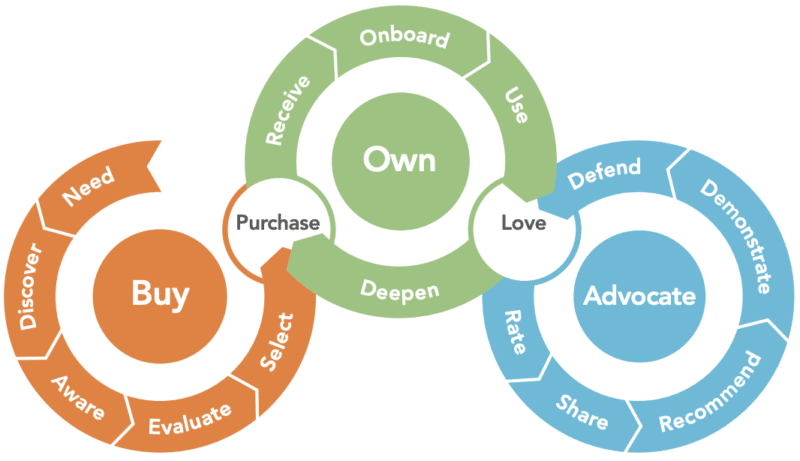A major theme at the upcoming MarTech conference will be the dramatic ways in which the customer journey has changed over the last two years. Our perception is that changes in consumer expectations and buying practices are reflected in similar changes for the B2B buyer.
To confirm that our perception is well-founded, we turned to John Bruno, VP strategy at PROS, the AI-powered platform that helps major brands price, configure and sell products and services. Bruno previously spent almost five years at Forrester on the sales technology and B2B e-commerce beat. “I have responsibility for our corporate strategy, a lot of what we do around go-to-market, as well as our corporate development where we think about mergers and acquisitions.”
In his role, Bruno spends a lot of time listening to the B2B sales teams that PROS serves. “Actually being a partner with our customers is really important to us. We do spend a lot of time talking to them about the dynamics in their markets, and they share with us stuff that they’re doing.” Additionally, it’s important to PROS to conduct internal research on the state of B2B selling. The company started out some 30 years ago helping airlines with dynamic pricing. Today, PROS is behind most of the world’s airfares, Bruno estimated, and also supports enterprise CPQ in many other verticals.
With B2B sales processes becoming digitized, many businesses aren’t far behind what airlines have been doing for so long, Bruno said.
Digitized B2B selling
“A lot of organizations started down this path before the pandemic,” said Bruno. “It’s always been on the priority list but may not, in previous years, have risen to the top three or top five. All the pandemic did was move it up the list. It was something every organization was going to tackle eventually, but that ‘eventually’ snuck up on people pretty quickly when the pandemic happened.”
A digitized customer journey was what many B2B buyers were craving. “The most valuable commodity we have in terms of customer engagement today is information. Historically speaking, that’s been something B2B organizations have often safeguarded — by holding onto information I can hold onto the power dynamic of the relationship. But now that information is more readily available, you’re no longer in control of that power dynamic — the customer is, and they can make more educated decisions.”
“You need to not put any roadblocks or barriers in their way,” Bruno said. “Quite frankly, if you’re going to make decisions pertaining to your sales process that create more friction for them there’s a lot of optionality out there for them to shop around and bring their loyalty elsewhere.”
Buyers, Bruno observed, overwhelmingly start their journeys on a digital device. This isn’t new. Bruno recalled from his Forrester days that the figure was something like 99% way back in 2017. “What’s different between then and now, you might have had a small sliver of research at the beginning of your buyer journey but because of what was then available to you, you then had to engage with a sales person or pick up the phone or send an email.” In 2022, B2B buyers can get much further on their journey — in some cases even complete the transaction — without support from sales.
Get the daily newsletter digital marketers rely on.
So what’s left for sales?
This purchasing environment means changes for B2B marketing, now charged with engaging with the customer further and further down the funnel, but also for B2B sales. “A lot of people think that, if marketing and these digital self-service technologies are doing so much for the customer, then the sales person’s job is going to be a lot easier. In reality, it’s quite the inverse,” Bruno said. “The job of a salesperson has become orders of magnitude more difficult.”
The reason is that the sales rep is typically dealing with prospective buyers that are already highly knowledgeable about products and services, likely without knowing what sources the buyer has been consuming. And the buyers can come armed with “very pointed questions.”
This implies the need for a fundamental change in what outcomes B2B sales reps are focused on. “For a lot of salespeople today, their outcome is still ‘Have I met my quota?’ What we’re going to start seeing is modern salespeople focused on the outcomes for their customer. In order for them to gain trust and credibility and build the kind of relationship they once had when all the power was in their court, it’s going to be dependent on their ability to help their customers achieve their outcomes. If you do that successfully, everything else will follow.”
Incentivizing the new sales model
“It’s going to take a little while to transition organizations away from the status quo of quota-based metrics,” Bruno admitted. There are emotional as well as financial attachments to that long-standing traditional model. “I have seen some interesting things done, though. For starters with this massive influx of digital engagement and self-service — what do you do with those orders? Do people get credit for them? A lot of organizations are looking at the micro-level, what’s happening with the individual rep and the individual team. Where organizations need to get to is thinking about it at the macro-level — what’s best for the business, which is often what’s best for the customer.”
One thing a lot of customers now value is the self-service option. Bruno mentioned a window company — think large, elaborate windows — which saw self-serve, digital transactions go from 10% to 80% of their business during the pandemic. “If your customers prefer self-service and the self-service channels are more profitable for you, then maybe you think about incentivizing your sellers on, one, their sales, but two, how good of a job they’re doing at enabling your customers. I have seen organizations embrace this notion of buyer enablement as a key metric for compensation.”
This approach would see sales moving much closer to a customer success role. There’s something else driving that.

Explore capabilities from vendors like Adobe, Pointillist, SharpSpring, Salesforce and more in the full MarTech Intelligence Report on customer journey analytics platforms.
The subscription economy drives long-term relationships
The influence of the subscription economy — widely, but not exclusively, seen in software sales, for example — should not be understated, Bruno agreed. “But there are many different flavors,” he said. “For example, Amazon: I want this product re-ordered with this frequency. I probably wouldn’t call that a subscription, it’s more of a recurring order. But as you evolve beyond that, you start talking about value, utilization. You think about transitioning from a capital, one-time purchase to more of a recurring relationship that’s value-oriented.”
B2B sellers will want subscription customers to renew, to be open to upselling, and also to keep them front-of-mind if they switch jobs.
Read next: How contact tracking tech can re-connnect brands with former customers
Competing on experience
“It’s undeniable that businesses increasingly compete on customer experience,” Bruno said. “That’s something we saw front and center in the B2C world. Back in those years at Forrester, we looked at customer experience largely through a B2C lens. It boiled down to three characteristics, one of which was ease of use; two, effectiveness — was I able to get done what I set out to get done? And three, emotion — how did it make me feel? B2B is not really an emotional purchase, so we did a lot of research to understand what that other component was for B2B. Guess what it was? It was trustworthiness.”
There’s been a lot of emphasis recently on the importance of building trust in consumer markets, but people don’t completely alter their personalities when they move from consumer purchasing to B2B buying. “If you’re able to convey to your customer that you have their best interests in mind, if you can earn that trust, your customer experience skyrockets.”
Why is that important? “Companies that win in customer experience tend to win in business metrics like sales, margin or profitability.”
Source link




